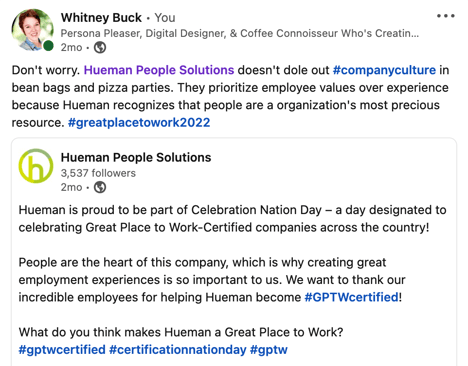Employee satisfaction and retention start with your company's recruitment strategy. Short-sighted hiring approaches can lead to costly turnover rates and lackluster teams.
According to a Retention Report by Work Institute, "35% of employees will leave their jobs each year by 2023 to go work elsewhere." It's evident that many employees have evaluated their priorities and have increased their expectations for employers. Opportunities for professional growth and career advancement remain at the top of the list, followed closely by companies whose values coincide with their own.
A survey of 2,202 workers by Flexjobs found that employees gave the following five top reasons for quitting:
- Toxic company culture (62%)
- Low salary (59%)
- Poor management (56%)
- Lack of healthy work-life boundaries (49%)
- Not allowing remote work (43%)
The struggle to satisfy employees may point to a simple solution for employee satisfaction: lessen employee churn by making your business a more desirable place to work.
Employers must understand that it takes a lot longer to find a candidate than it does for employees to submit their two-week notice and leave. How to solve for this? Increase employee engagement while bolstering retention. Companies must redefine what it means to be a part of their business to align themselves with their workforce.
These ten strategies will have the most significant impact when it comes to retention tactics:
1. Companies Need to Show They're a Great Place to Work
A contemporary, adaptable, bottom-up corporate culture is essential for success. When employees feel that they are heard and what they have to say matters, companies will be better equipped to establish an inclusive, transparent atmosphere where all sorts of individuals can thrive. To date, culture is still one of the top three influencers for employee job satisfaction. Dissatisfied employees are 15 percent more likely to pursue new opportunities.
Therefore, companies need to maintain control over their narrative and convey to potential workers how much they're valued. Not only will creating a great place to work help with employee retention and job satisfaction, but it can also help you attract higher-quality candidates. Employees can share their satisfaction on social media. Here's an example from our own social media account.

Once you start receiving these types of employee testimonials and stories, share them on your website and career portals as an effective form of social proof for future applicants.
2. Companies Need to Actually Be a Great Place to Work
Don't make your company culture just a story — live it. Supporting your current workforce is the first step in developing a great company culture — and we should know. Hueman has been honored by Great Place to Work® and Fortune magazine for 16 years and ranked as Gallup's Most Engaged Workforces In The World in 2016, 2018, and 2020.
"Recognitions like these are only possible because of our incredible employees who have made us a part of this list for the past 16 years. Our employees are what keeps this company going and are a great part of our success which is why it's extremely important to us that we provide a workplace that they value as much as we value them." - Dwight Cooper, CEO of Hueman
The best talent will always have the option to choose where they want to work, regardless of the state of the employment market. Businesses should take steps not to let someone else have them, especially when the typical cost of replacing one person may be between one-half and two times their yearly compensation.
While trust, respect, and camaraderie are fundamental elements of all successful workplaces, the specifics of what a company does to benefit employees is pivotal to accomplishing their intended culture. By studying the finest, you may consider what appeals to you, your business, and your workforce.
3. Improve the Work-Life Balance of Employees
The new normal of hybrid or completely remote work environments has made it all but mandatory to prioritize work-life balance. Many people would rather perform a less demanding job for less money than continue in a position that doesn't allow for relaxation or remote opportunities.
Leaders can audit workloads to ensure everyone gets the proper amount of work each day and has time for personal activities. The key to all of this is straightforward and regular communication with employees. This will make it simpler for managers and team leaders to spot signs of workload dissatisfaction or even the beginnings of burnout. Having these discussions ahead of deadlines enables easy changes with little impact on your deliverables.
4. Emphasize Strengths Over Weaknesses
When leaders are in high-stress environments, it's easy to dehumanize employees and forget the impact their work experiences have on the rest of their lives. Fixating on people's weaknesses can create negative spirals that cause performance to deteriorate even further.
Instead of focusing on what workers are doing wrong, team leads should encourage them to keep up the good work in areas where they show promise. One Gallup study showed that 61% of participants who worked in strengths-focused environments said they were engaged at work. In contrast, only 22 percent of people whose managers emphasized weaknesses said the same.
5. Offer Mentoring Initiatives
A rational way to emphasize strengths brings us to our next strategy: implementing mentorship programs. Lack of investment in learning and development is one of the most significant errors businesses make. Employees need to know that you're ready to put money into helping them reach their full potential.
LinkedIn's 2022 Workplace Learning Report states that "94% of employees said they would stay at a company longer if they were offered opportunities to learn and grow." A successful employee engagement plan must include tools for prioritizing career development talks. For instance, companies can match a new employee with a person in their ideal position. This increases mobility and enhances the work experience, which is crucial for employee retention.
Additionally, employees from historically marginalized groups can overcome institutional hurdles with the aid of mentoring programs. Retaining outstanding personnel requires fostering an atmosphere where everyone can succeed, regardless of their experience.
6. Offer Professional Development Through Constructive Feedback
Employees long for feedback. A channel of communication with supervisors that is always centered on an employee's abilities can help people stay motivated at work.
However, just one-third of workers get one-on-one coaching and feedback from their direct boss. When team members don't receive frequent feedback, they may question how they're doing and feel lost or disengaged. Employees will feel underappreciated if they only get feedback from bosses when they make mistakes.
Leaders should learn the value of giving constructive, encouraging feedback to employees. Several tools are available to help communicate performance issues focused on the future rather than on the intricacies of current tasks.
7. Create Balanced Challenges for Teams
Employees need to feel challenged to stay motivated at work; if they do the same thing every day for years on end, they will eventually become bored. Workers should have the chance to overcome pertinent problems in their job.
These challenges should be constructive rather than harmful. Examples include finding a solution to a company issue or giving staff members more responsibility. To start, each employee should have one to three quarterly goals. Creating goals that propel the company forward and allow employees to take on complex tasks relevant to their career goals leads to more manager engagement.
8. Practice Transparency
For employees to be loyal, their trust must be earned. That trust is gained by offering candid updates about the business's performance and growth, along with addressing people's concerns head-on. Sharing the leadership's vision for the organization and explaining how employees fit into its future ensure employees know they're essential to the company and allow them to be part of something greater than themselves.
9. Offer Fair Compensation
This should be obvious, but competitive pay is a must for employees. Team members are considerably more inclined to consider quitting if they can perform the same tasks for a higher salary at another employer. Of course, money isn't everything; there are many other reasons why workers leave their jobs. However, having enough money and providing for their family is a pretty strong driver.
To hold on to workers, companies must provide competitive pay and benefits. Keep up with the most recent salary trends for each position. Regularly update pay scales to suit the broader market and conduct employee surveys to find out which perks are most valued by your workers.
10. Implement a System of Recognition and Rewards
Everyone wants to feel valued for their efforts. And an employer's appreciation may have a particularly significant influence on today's "anywhere workforce." Therefore, leaders should commend direct reports for going above and above and highlight how their efforts benefit the company. Some businesses create formal incentive systems to encourage creative thinking and innovation.
For example, the Gorilla Glue Company features "Company-wide team-building events, cross-functional outings, ongoing focus groups, and a conversational atmosphere." Their 'People Committee' is centered around better communication and employee recognition.
At Hueman, we recognize employees with weekly Core Value Awards, commending workplace representations of our company-wide core values: Excellence, Trust, Change, Teamwork, and Leadership.
Employee Satisfaction and Employee Retention Go Hand and Hand
Company culture will determine whether your retention strategy succeeds or fails. Retention will increase if workers feel included in and at home within your corporate culture. However, they are more likely to depart if they believe that culture is toxic and depletes their energy.
Connection is a crucial element of culture, and it requires intentional cultivation, particularly in mixed and isolated situations. Employee engagement and loyalty will increase when they feel a sense of belonging to the company, its leaders, and each other.
Want to learn more about attracting candidates to your business? Connect with us today!



